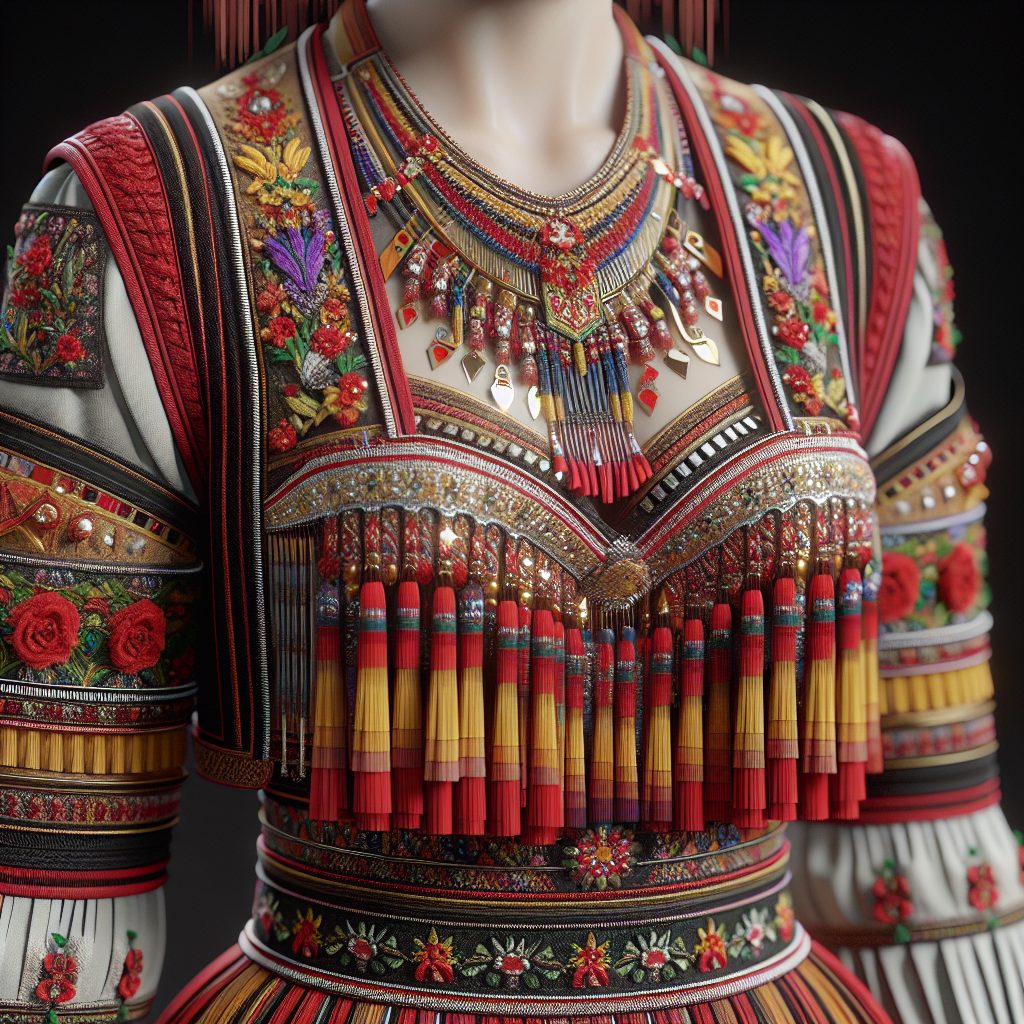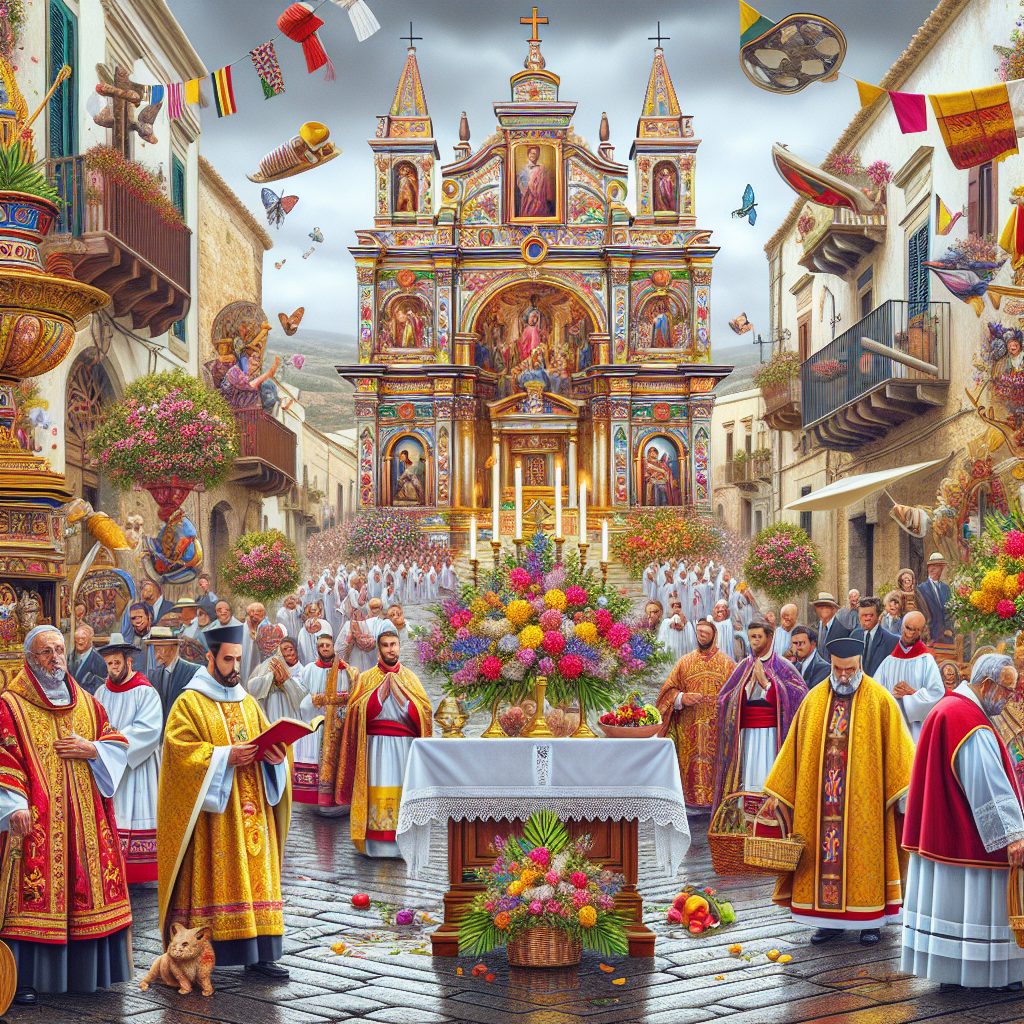Sardinian traditional clothing, also known as “costume,” holds a significant place in the rich cultural heritage of the Italian island of Sardinia. With intricate designs, vibrant colors, and unique craftsmanship, this traditional attire is a visual testament to the island’s history, traditions, and identity. Sardinian costume is not merely a fashion statement but a reflection of the islanders’ sense of belonging and pride.
One of the striking features of Sardinian traditional clothing is its regional diversity. Each town and village on the island has its own distinct costume, representing its unique cultural identity. This diversity is evident in the variation of fabrics, patterns, accessories, and even embroidery techniques. Moreover, the details of the attire often convey valuable insights into the wearer’s social status, occupation, and personal history. The intricacy and labor-intensive nature of creating these costumes emphasize the local craftsmanship and the dedication to preserving the island’s cultural heritage.
In the upcoming sections, we will delve deeper into the world of Sardinian traditional clothing. We will explore the historical significance of each element, unravel the meanings behind the intricate patterns and symbols, and discover how these costumes continue to influence contemporary fashion. From the iconic “Sa Berritta” headgear to the “Faldetta” ceremonial cape, we will unravel the secrets of Sardinia’s traditional attire, shedding light on its profound cultural and artistic implications. Let’s take a captivating journey into the traditional world of Sardinian clothing, uncovering the profound stories and meanings woven into each thread and stitch.
Key Takeaways
1. Sardinian traditional clothing is a significant aspect of Sardinian culture and identity, with various garments reflecting the history, customs, and social status of its wearers.
2. The most well-known Sardinian traditional clothing item is the “grembiule,” a decorated apron worn by women during special occasions and regional festivals.
3. The intricate embroidery and vibrant colors used in Sardinian traditional garments showcase the rich artistic heritage and craftsmanship of the island.
4. The importance of traditional clothing in Sardinia is demonstrated through the presence of numerous museums and festivals dedicated to preserving and promoting this cultural heritage.
5. Despite the decline in everyday use of traditional clothing, efforts are being made to revive and modernize these garments, ensuring their continuation and relevance in contemporary Sardinian society.
What are the Key Aspects of Sardinian Traditional Clothing?
Traditional Attire for Men and Women
Sardinian traditional clothing is a reflection of the island’s rich cultural heritage and history. The attire varies for men and women, with each gender having unique garments and accessories that define their traditional outfits.
Men’s Traditional Clothing
In Sardinia, men traditionally wear a “giponeddu,” which is a long-sleeved white shirt with embroidered details. This shirt is worn with “su gilet,” a sleeveless waistcoat adorned with intricate patterns. Another essential element of men’s clothing is the “pantu,” which are wide, baggy pants made of dark fabric. A wide belt called “su berrittu” is also worn to secure the pants. Additionally, traditional footwear includes “su carrapaxiu,” a type of leather shoe.
Women’s Traditional Clothing
Women’s traditional attire in Sardinia is characterized by vibrant colors and elaborate designs. The main garment is a long, sleeveless dress called “su “andasa” or “saietta,” which is usually made from finely woven fabric. The dress is richly decorated with delicate embroidery and lacework. Women also wear an apron called “su mezzaluna,” which is worn around the waist and made from colorful fabric. To complete the ensemble, women wear handmade jewelry, including elaborate necklaces, earrings, and brooches.
Symbolism and Significance
Sardinian traditional clothing holds deep symbolism and significance. The intricate designs and choice of colors often represent various aspects of the island’s culture and history. For example, the embroidery on men’s shirts may depict ancient motifs or religious symbols, while the colorful patterns on women’s dresses can symbolize fertility, prosperity, and protection from evil spirits. Wearing traditional attire is also a way for Sardinians to connect with their ancestors and preserve their cultural identity.
Occasions and Festivities
Sardinian traditional clothing plays a significant role in various occasions and festivities throughout the year. Festivals like “Sa Sartiglia” and “Cavalcata Sarda” provide glimpses of the island’s vibrant cultural traditions, where locals dress in their finest traditional attire. These events celebrate the island’s history, equestrian skills, and showcase traditional dances and music. Additionally, traditional clothing is often worn during weddings, religious ceremonies, and other cultural gatherings as a way to honor Sardinian heritage.
Preserving and Reviving Sardinian Traditional Clothing
In recent years, there has been a renewed interest in preserving and reviving Sardinian traditional clothing. Various initiatives have been undertaken by local communities and artisans to ensure the continued production of authentic garments. Traditional weaving techniques, embroidery skills, and craftsmanship are passed down through generations to keep the traditions alive. By supporting local artisans and wearing traditional clothing, the Sardinian community aims to maintain their cultural heritage for future generations.
Guide to Appreciating Sardinian Traditional Clothing
- Visit Sardinian Festivals: Experience the vibrant atmosphere and witness locals proudly wearing their traditional clothing during festivals like “Sa Sartiglia” and “Cavalcata Sarda.”
- Learn about Symbolism: Dive into the meaning behind the intricate designs and patterns on Sardinian traditional attire. Discover the stories and symbolism that enrich the garments.
- Support Local Artisans: Purchase authentic Sardinian traditional clothing from local craftsmen. By doing so, you contribute to the preservation of this unique cultural heritage.
- Participate in Workshops: Engage in workshops organized by local artisans to learn traditional weaving or embroidery techniques associated with Sardinian clothing.
- Share the Knowledge: Spread awareness about the beauty and significance of Sardinian traditional clothing. Share your experiences and knowledge with others, helping to keep this heritage alive.
FAQ
1. What is Sardinian traditional clothing?
Sardinian traditional clothing refers to the attire worn by the locals of Sardinia, an island region in Italy. It is a representation of their rich cultural heritage and varies across different regions of the island.
2. What are the key components of Sardinian traditional clothing?
The key components of Sardinian traditional clothing include the “gipi” (a shirt for women), “sa berritta” (a traditional hat), “sos coletes” (vests for men), and “is wattas” (woolen skirts for women). These clothing pieces are often adorned with intricate embroidery and traditional patterns.
3. Are there different styles of Sardinian traditional clothing?
Yes, there are various styles of Sardinian traditional clothing. The styles differ based on the region and the occasion. For example, women in the Nuoro region may wear “su currettu,” a high, pleated skirt, while men in the Gallura region wear a distinctive jacket called “su giponeddu.”
4. Is Sardinian traditional clothing still worn today?
Yes, Sardinian traditional clothing is still worn today, especially during traditional festivities, weddings, and cultural events. It serves as a symbol of pride and identity for the Sardinian people.
5. Where can one purchase Sardinian traditional clothing?
Sardinian traditional clothing can be purchased in local markets, artisan shops, and specialized stores across the island. Online platforms also offer a wide range of options for those interested in acquiring these traditional garments.
6. Can anyone wear Sardinian traditional clothing?
Yes, anyone can choose to wear Sardinian traditional clothing. Many tourists and visitors to Sardinia often appreciate and embrace the opportunity to experience the local culture by wearing traditional garments.
7. Are there any specific rules or customs associated with wearing Sardinian traditional clothing?
While there are no strict rules, it is important to wear Sardinian traditional clothing respectfully and appreciate its cultural significance. For example, certain garments may be reserved for specific genders or occasions, so it is advisable to seek guidance from locals or experts.
8. Can Sardinian traditional clothing be customized?
Yes, Sardinian traditional clothing can be customized to a certain extent. However, it is essential to respect the traditional designs and patterns which carry historical and cultural significance.
9. Are there any modern adaptations of Sardinian traditional clothing?
Yes, there are modern adaptations of Sardinian traditional clothing that incorporate contemporary styles and fabrics. These adaptations aim to blend traditional elements with modern fashion trends, catering to a wider audience.
10. What is the importance of Sardinian traditional clothing?
Sardinian traditional clothing holds great importance as it represents the island’s cultural heritage, reinforces a sense of belonging among the locals, and showcases their unique identity to the world. It contributes to the preservation of traditional craftsmanship and the continuation of ancestral traditions.
Final Thoughts
Exploring the world of Sardinian traditional clothing is like entering a time portal that reveals the beauty and richness of the island’s cultural legacy. The intricate embroidery, vibrant colors, and unique designs encapsulate the essence of Sardinia’s traditions.
Whether it’s the elegant women’s attire or the stylish men’s garments, each piece reflects the island’s history, customs, and values. By appreciating and embracing Sardinian traditional clothing, we can honor the craft of local artisans and contribute to the preservation of this captivating heritage for future generations to cherish.






